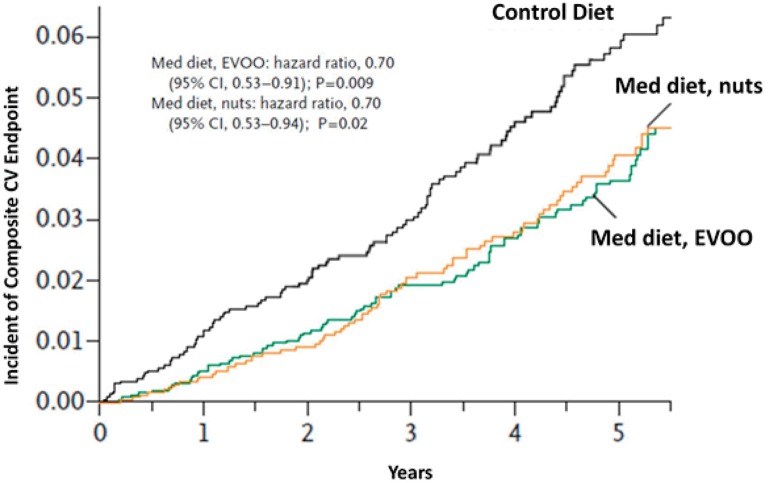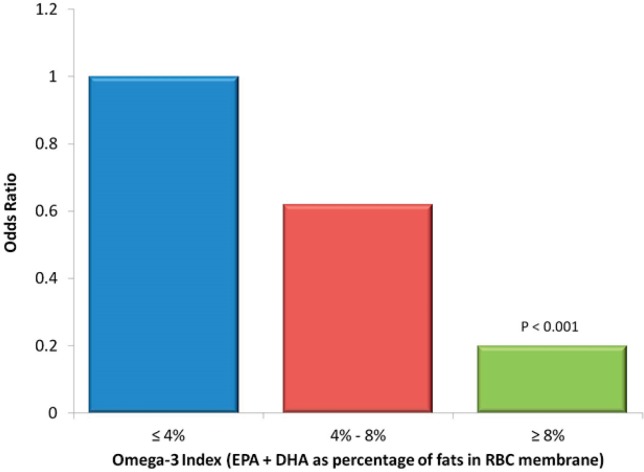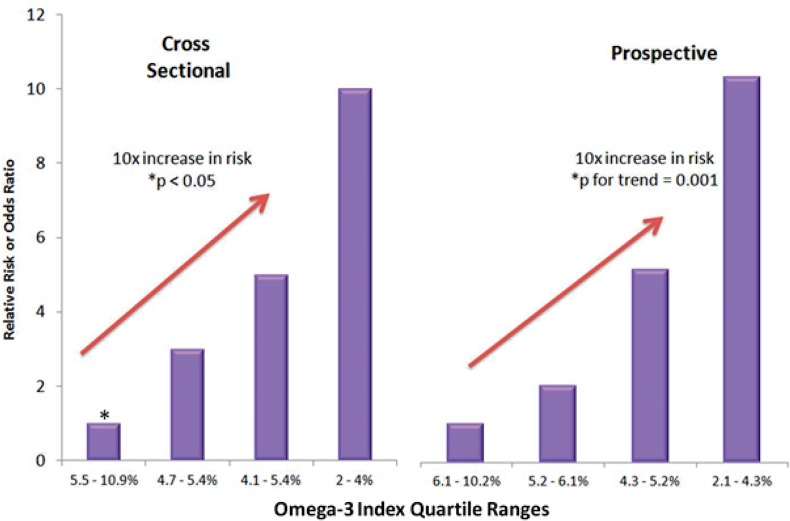Abstract
Recently, debate has erupted in both the scientific community and throughout the lay public around whether a low-fat or low-carbohydrate diet is better for weight loss. In other words, is it better to cut fat or cut carbohydrate for weight loss. However, going beyond this debate (fat versus carbohydrate), are questions around whether certain fatty acids are worse for promoting insulin resistance, inflammation, and obesity. The overall evidence in the literature suggests that medium-chain saturated fats (such as lauric acid, found in coconut oil) and monounsaturated fat (oleic acid, found in olive oil) are less likely to promote insulin resistance, inflammation, and fat storage compared to long-chain saturated fatty acids (such as stearic acid found in large quantities in butter, but particularly palmitic acid found in palm oil) especially when consumed on top of a diet moderate in refined carbohydrates. Compared to long-chain saturated fats, lauric acid and oleic acid have an increased fatty acid oxidation rate, are more likely to be burned for energy and less likely to be stored in adipose tissue, and thus promote increased energy expenditure. Omega-6 polyunsaturated fatty acids (PUFAs), such as linoleic acid, as found in vegetable oils may contribute to obesity, whereas omega-3 PUFA may be protective. Importantly, both olive oil as part of a Mediterranean diet, and omega-3 from fish and fish oil have been proven to reduce risk of cardiovascular (CV) events.
Introduction
Obesity is characterized by an accumulation of adipose tissue either subcutaneously (underneath the skin) or ectopically (in and around organs). While many factors contribute to obesity, this paper will focus on the differences between fatty acids around insulin resistance, inflammation, and fat storage.
Upon their consumption, certain fatty acids are more likely to be stored in adipose tissue versus being burned for energy. This can be measured by the fatty acid oxidation rate after fatty acid ingestion. Medium-chain saturated fatty acids (C6–C12), alpha-linolenic acid (ALA), oleic acid, and linoleic acid have particularly high oxidation rates compared to certain long-chain saturated fats such as palmitate (16:0) and stearate (18:0).1 In one study, the cumulative oxidation of different fats in humans over a nine-hour period from highest to lowest was laurate (41%), oleate (18%), palmitate (16%) and stearate (13%).2 In other words, long-chain saturated fats were less likely to be burned (lower oxidation rate) compared to laurate (found in coconut oil) and oleate (found in olive oil).
One study in eight normolipidemic subjects compared three isocaloric diets that were either high in saturated fatty acids (SFA), omega-6 polyunsaturated fatty acid (PUFA) or omega-3 PUFAs (30% of the fat came from fish oil) over 25 days. Each of the diets contained the same percentage of macronutrients (43% carbohydrate, 42% fat, and 15% protein). A fatty meal was then used for a fat loading test, consisting of 20% carbohydrate, 65% fat and 15% protein. Two fat loading tests were performed on each diet. Fasting insulin and the incremental two-hour post-prandial insulin over the fasting insulin from lowest (best) to highest (worst) were as follows, SFA diet (8 uU/ml and 10 uU/ml), omega-3 diet (12uU/ml and 14 uU/ml), and omega-6 PUFA diet (14 uU/ml and 25 uU/ml). Although the differences were not statistically significant, the particularly high insulin levels promoted by dietary omega-6 PUFAs suggests that these fatty acids in particular may promote greater fat storage compared to long-chain omega-3s or SFAs when consumed on top of a diet moderately high in carbohydrate.3 Mechanisms whereby omega-6 PUFAs may promote fat mass accumulation include inhibition of omega-3s anti-obesogenic effects (such as increased fatty acid oxidation, increased basal metabolic rate, increased protein and muscle synthesis) and promotion of fat-storing prostaglandins, endocannabinoids and increased hunger.4 Observational studies support this notion, whereby central obesity is positively associated with omega-6 PUFAs in adipose tissue but inversely with MUFAs and omega-3 PUFAs.5
The Kanwu study compared a diet high in SFAs to a diet high in MUFA in 162 healthy individuals on top of a diet moderately high in carbohydrate (∼ 45% of total calories).6 Those consuming the SFA diet used butter and table margarine high in SFA, whereas the MUFA diet used spreads and margarine with high proportions of oleic acid from high-oleic sunflower oil. Patients were instructed to eat isocaloric diets containing 37% energy from fat, the SFA-enriched diet containing 17% SFA, 14% MUFA and 6% PUFA and the MUFA-enriched diet containing 8% SFA, 23% MUFA and 6% PUFA. Insulin sensitivity was impaired (−10%, p = 0.05 borderline significance) in the diet higher in SFAs, whereas no change occurred in the MUFA diet. Moreover, in those eating less than 37% total energy as fat the difference between the groups was statistically significant (20.3% difference, p < 0.03). Insulin sensitivity was 12.5% lower in the diet higher in SFAs and 8.8% higher on the diet high in MUFA. Thus, a diet higher in MUFA may improve insulin sensitivity compared to a diet higher in SFAs when consumed on top of a diet moderately high in carbohydrates. These results may have been in part due to differences in the foods eaten in the diets, rather than the exchange of MUFA versus SFAs per se.6 (See Table 1).
Table 1.
|
A randomized parallel controlled-feeding trial was performed in 60 non-diabetics (40–65 years old) with mild abdominal obesity.7 After consuming a two-week run-in diet high in saturated fat (19% energy), patients were placed on a high MUFA diet (20% energy), a Mediterranean diet (MUFA 21% energy) or high SFA diet for 8 weeks (carbohydrate intake was 47.3% energy in SFA, 46.4% in MUFA and 41.1% in Mediterranean diet). The high MUFA diet reduced TC, LDL-C and the TC/HDL compared to the SFA-diet. There was no significant difference in insulin levels or insulin sensitivity between the diets (no difference in C-peptide, HOMA-IR and glucose). The authors concluded, “…in our controlled-feeding trial, a high MUFA-diet and a Mediterranean diet did not affect insulin sensitivity compared to a high SFA-diet.”
This result was similar to a paper published by Lovejoy and colleagues comparing diets high in SFA (9%), MUFA (9%) or trans-fat (9%) that found no difference in insulin sensitivity on top of a high carbohydrate intake (57% energy).8 However, insulin sensitivity did worsen by 24% in the SFA versus the MUFA diet in overweight subjects. Thus, the evidence appears to indicate that a diet higher in MUFA is slightly better for improving insulin sensitivity compared to a diet high in SFAs in certain individuals (those eating less than 37% energy as fat or in those who are overweight who are eating a diet moderately high in carbohydrate).
Due and colleagues randomized 46 non-diabetic obese men and women to one to three diets: 1) a MUFA diet moderately high in fat (35–45% of total calories from fat, of which MUFA was > 20% energy); 2) a low-fat diet (20–30% of total calories energy from fat); and, 3) a control diet (35% of total calories from fat, of which saturated fat was > 15% energy).9 Compared to the MUFA diet, the diet high in SFAs (the control diet) significantly increased fasting glucose, fasting insulin and HOMA-IR (a measurement homeostasis model assessment of insulin resistance). However, the MUFA diet was also a low-glycemic diet, whereas the low-fat and control diets were medium and high-glycemic, respectively. Thus, the findings could be the result of the differences in the glycemic index of the diets rather than the differences in fatty acid composition.
Another study in 14 male volunteers showed that the five-hour postprandial fat oxidation rate was higher with a breakfast meal (42% carbohydrate, 43% fat, 15% protein) containing MUFA (extra virgin olive oil) versus cream.10 In patients with a high waist circumference, there was also a significant increase in the thermic effect with the MUFA-rich versus the SFA-rich meal. The thermic effect of food is the amount of energy expenditure above the basal metabolic rate due to the processing of food. Thus, the amount of energy required to process MUFA was higher than that of SFA when moderate amounts of carbohydrate are consumed. This may partially explain why studies have shown increased fat and weight loss with MUFA versus SFA diets. For example, protein has a higher thermic effect (requires more energy to process) compared to carbohydrate and thus more calories are burned when consuming equal amounts of calories from protein versus carbohydrates.11
In humans, increasing the palmitic acid/oleic acid ratio reduces daily energy expenditure in men and decreases fat oxidation in the fed and fasted state in women.12 In postmenopausal women, postprandial fat oxidation rate is higher after an isocaloric meal that includes extra virgin olive oil (EVOO) versus cream.13 In this trial, in those who were obese, diet-induced thermogenesis was significantly higher in the isocaloric meal containing EVOO vs. cream (5.1% vs. 2.5%, p = 0.01, respectively). The authors concluded, “The present study showed that olive oil significantly promoted postprandial fat oxidation and stimulated diet-induced thermogenesis in abdominally obese postmenopausal women.”13 Meals enriched with MUFA vs. SFA have provided increased fat oxidation rates.10 And the high oxidation rate of laurate may explain the lower weight gain that occurs with medium-chain saturated fats versus longer chain saturated chain fats.2, 14 Medium chain saturated fats (8–14 carbons) are also oxidized slightly faster than even ALA and oleic acid.15 This is partially why medium chain triglycerides are suggested for weight loss.
While it is well known that fatty acids enter muscle tissue in order to be oxidized for ATP production used for muscle contraction, it is less commonly known that MUFA may be directed more towards oxidation than long-chain SFA. Thus, long-chain SFAs are more likely to be stored in muscle versus MUFA, especially on top of a diet high in refined carbohydrates. This is why SFAs may cause greater muscle insulin resistance via increased intramyocellular lipid accumulation. Moreover, long-chain SFAs, as compared to unsaturated fats, are more readily incorporated into diacylglycerol (DAG) versus triacylglycerol (TAG), which may also increase inflammation and insulin resistance.
Palmitate can increase the cellular content of DAG and ceramide, which are pro-inflammatory molecules, whereas oleate mainly increases TAG, which is less inflammatory.16, 17 SFAs have a lower affinity for DGAT2, the enzyme that converts DAG to TAG. This is why long-chain SFAs are more likely to be stored as DAG compared to TAG. And long-chain SFAs are also the rate limiting substrate of serine palmitoyl-transferase, which is the enzyme that forms ceramide, which is why ceramide formation is greater with long-chain SFAs compared to unsaturated fatty acids.1
Different fats have varying effects on insulin signaling and cell health. Incubating human myotubes with palmitate causes insulin resistance, whereas no such effect was found with oleate.16, 18 Palmitate also increases ceramide synthesis, caspase 3 activation and apoptosis in skeletal muscle myotubes.19 These results are likely only relevant in those with hyperinsulinemia or who are eating a moderate to high amount of refined carbohydrate, as dietary SFA per is not the main factor determining increases in palmitate in the body but rather refined carbohydrate intake.20 Thus, the combined intake of refined carbohydrates with long-chain SFAs, which is typical for the standard American diet, creates the perfect storm for precipitating insulin resistance, inflammation, and obesity.
The Mediterranean diet is well known for its ability to improve the metabolic syndrome. Indeed, one study concluded, “Adherence to a Mediterranean diet is modestly associated with a better insulin sensitivity, lower levels of total cholesterol and lower levels of systolic blood pressure (BP) in overweight and obese subjects.”21 A meta-analysis of 50 studies (prospective studies and clinical trials) in over 500,000 individuals has found that the Mediterranean does indeed reduce the risk of the metabolic syndrome.22 Olive oil may partially explain the benefits of a Mediterranean diet. Indeed, olive oil has been found to “rescue” palmitate-induced cell death by decreasing its incorporation into DAG and ceramides through multiple mechanisms including enhanced beta-oxidation and increasing its synthesis into TAG.1, 23 Thus, by shunting palmitate into the TAG pool and increasing its beta-oxidation, oleic acid may be able to reduce the harms of a diet high in refined carbohydrates plus long-chain SFAs.20
Most foods that are high in saturated fat are also high in oleic acid. Thus, demonizing saturated fats per se is inappropriate, especially when the concomitant intake and type of dietary carbohydrate is not considered. However, on top of a diet that is moderate to high in refined carbohydrates, a diet higher in oleic acid, as compared to long-chain saturated fats (particularly palmitic acid found in full-fat dairy and palm oil) will likely improve insulin resistance and promote fat loss. In other words, reaching for olive oil compared to heavy cream or butter will likely lead to less fat gain when consumed on top of a diet moderately high in refined carbohydrates. And this has been shown in a randomized cross-over study.24 Indeed, in overweight or obese men replacing a diet high in SFA with MUFA for four weeks significantly reduced body weight (−2.1 kg) and fat mass (−2.6 kg) despite the same number of calories and fat being consumed.
Long-chain saturated fats are also more likely to be retained in the liver, whereas MUFA is more likely to enter muscle cells.1 Cell line studies using endothelial and vascular smooth muscle cells have found that palmitate induces cardiovascular (CV) insulin resistance, whereas oleate had a protective effect against palmitate induced insulin resistance.25 The authors concluded, “…oleate protects against CV insulin resistance, improves endothelial dysfunction in response to proinflammatory signals and finally, reduces proliferation and apoptosis in vascular smooth muscle cells that may contribute to an ameliorated atherosclerotic process and plaque stability.” Elevated levels of palmitate may also induce inflammation and insulin resistance in skeletal muscles via diacylglycerol-mediated activation of protein kinase C and activation of toll-like receptors.25 However, oleic acid has even been found to prevent mitochondrial dysfunction, inflammation and insulin resistance in neuronal cells25, 26 and skeletal muscle27, 28 induced by palmitate.
Long-chain saturated fats (such as palmitic acid 16:0 and stearic acid 18:0) are more likely to be retained in the liver and skeletal muscle compared to oleic acid, which is reflected by the lower postprandial oxidation rate of long-chain SFAs compared to oleic acid.1 This may also reflect MUFA being more readily packaged into VLDL triglycerides and exported out of the liver rather than being stored in adipose tissue. Additionally, compared to SFA, MUFA is more readily taken up by peripheral tissues, which may also lead to lower non-esterified fatty acid levels and less insulin resistance.1 Palmitate may particularly increase visceral fat storage, whereas oleate seems to store fat in subcutaneous adipocytes.29 Fat storage versus burning is ultimately determined by the background intake of refined carbohydrates and the type of fat (palmitic acid being stored in the visceral fat, whereas oleic acid is generally stored subcutaneously). This has been confirmed in obese patients, whereby greater amounts of saturated fats are stored ectopically (perivascularly), whereas monounsaturated fats are stored subcutaneously.5
Conclusion
In summary, a diet high in MUFA (for example, olive oil, avocados, almonds, peanuts, macadamia nuts or hazelnuts) will likely lead to improvements in insulin resistance as well as fat and weight loss compared to diets higher in long-chain SFAs (for example, cream or butter). A diet higher in omega-6 PUFA as compared to long-chain omega-3 PUFA may also promote insulin resistance, inflammation, and obesity. Importantly, olive oil and nuts as part of a Mediterranean diet (See Figure 1),31 and omega-3 from fish and fish oil (See Figures 2 and 3)32 have all been proven to reduce risk of CV events. Thus, a high-fat diet rich in certain fatty acids from natural foods such as olive oil, nuts, avocados, and oily fish can reduce obesity and improve long-term CV health.
Figure 1.
Kaplan-Meier Estimates of the Incidence of Outcome Events in the Total Study Population: The incidence of the primary end-point (a composite of acute myocardial infarction, stroke, and death from CV causes). Hazard radios were stratified according to center (Cox model with robust variance estimators). CI denotes confidence interval, EVOO extra-virgin olive oil, and Med Mediterranean.31
Figure 2.
Omega-3 index as a risk factor for coronary heart disease.32
Figure 3.
Risk of primary cardiac arrest as a function of quartiles of red blood cell EPA plus DHA levels. 32
Biography
James J. DiNicolantonio, PharmD, (left), and James H. O’Keefe, MD, (right), MSMA member since 2003, are at Saint Luke’s Mid America Heart Institute, Kansas City, Missouri.
Contact: jjdinicol@gmail.com


Footnotes
Disclosure
JO is Chief Medical Officer and Founder of CardioTabs, a nutraceutical company. He has a major ownership interest in the company. CardioTabs does sell products that contain Omega-3. JD is the author of The Salt Fix and operates the website thesaltfix.com.
References
- 1.Bergouignan A, Momken I, Schoeller DA, et al. Metabolic fate of saturated and monounsaturated dietary fats: the Mediterranean diet revisited from epidemiological evidence to cellular mechanisms. Prog Lipid Res. 2009;48:128–147. doi: 10.1016/j.plipres.2009.02.004. [DOI] [PubMed] [Google Scholar]
- 2.DeLany JP, Windhauser MM, Champagne CM, et al. Differential oxidation of individual dietary fatty acids in humans. Am J Clin Nutr. 2000;72:905–911. doi: 10.1093/ajcn/72.4.905. [DOI] [PubMed] [Google Scholar]
- 3.Weintraub MS, Zechner R, Brown A, et al. Dietary polyunsaturated fats of the W-6 and W-3 series reduce postprandial lipoprotein levels. Chronic and acute effects of fat saturation on postprandial lipoprotein metabolism. J Clin Invest. 1988;82:1884–1893. doi: 10.1172/JCI113806. [DOI] [PMC free article] [PubMed] [Google Scholar]
- 4.Simopoulos AP, DiNicolantonio JJ. The importance of a balanced omega-6 to omega-3 ratio in the prevention and management of obesity. Open Heart. 2016;3:e000385. doi: 10.1136/openhrt-2015-000385. [DOI] [PMC free article] [PubMed] [Google Scholar]
- 5.Garaulet M, Perez-Llamas F, Perez-Ayala M, et al. Site-specific differences in the fatty acid composition of abdominal adipose tissue in an obese population from a Mediterranean area: relation with dietary fatty acids, plasma lipid profile, serum insulin, and central obesity. Am J Clin Nutr. 2001;74:585–591. doi: 10.1093/ajcn/74.5.585. [DOI] [PubMed] [Google Scholar]
- 6.Vessby B, Uusitupa M, Hermansen K, et al. Substituting dietary saturated for monounsaturated fat impairs insulin sensitivity in healthy men and women: The KANWU Study. Diabetologia. 2001;44:312–319. doi: 10.1007/s001250051620. [DOI] [PubMed] [Google Scholar]
- 7.Bos MB, de Vries JH, Feskens EJ, et al. Effect of a high monounsaturated fatty acids diet and a Mediterranean diet on serum lipids and insulin sensitivity in adults with mild abdominal obesity. Nutr Metab Cardiovasc Dis. 2010;20:591–598. doi: 10.1016/j.numecd.2009.05.008. [DOI] [PubMed] [Google Scholar]
- 8.Lovejoy JC, Smith SR, Champagne CM, et al. Effects of diets enriched in saturated (palmitic), monounsaturated (oleic), or trans (elaidic) fatty acids on insulin sensitivity and substrate oxidation in healthy adults. Diabetes Care. 2002;25:1283–1288. doi: 10.2337/diacare.25.8.1283. [DOI] [PubMed] [Google Scholar]
- 9.Due A, Larsen TM, Hermansen K, et al. Comparison of the effects on insulin resistance and glucose tolerance of 6-mo high-monounsaturated-fat, low-fat, and control diets. Am J Clin Nutr. 2008;87:855–862. doi: 10.1093/ajcn/87.4.855. [DOI] [PubMed] [Google Scholar]
- 10.Piers LS, Walker KZ, Stoney RM, et al. The influence of the type of dietary fat on postprandial fat oxidation rates: monounsaturated (olive oil) vs saturated fat (cream) Int J Obes Relat Metab Disord. 2002;26:814–821. doi: 10.1038/sj.ijo.0801993. [DOI] [PubMed] [Google Scholar]
- 11.Lucan SC, DiNicolantonio JJ. How calorie-focused thinking about obesity and related diseases may mislead and harm public health. An Alternative Public Health Nutrition. 2014;18(4):571–581. doi: 10.1017/S1368980014002559. [DOI] [PMC free article] [PubMed] [Google Scholar]
- 12.Kien CL, Bunn JY. Gender alters the effects of palmitate and oleate on fat oxidation and energy expenditure. Obesity. 2008;16:29–33. doi: 10.1038/oby.2007.13. [DOI] [PMC free article] [PubMed] [Google Scholar]
- 13.Soares MJ, Cummings SJ, Mamo JC, et al. The acute effects of olive oil v. cream on postprandial thermogenesis and substrate oxidation in postmenopausal women. Br J Nutr. 2004;91:245–252. doi: 10.1079/BJN20031047. [DOI] [PubMed] [Google Scholar]
- 14.Lasekan JB, Rivera J, Hirvonen MD, et al. Energy expenditure in rats maintained with intravenous or intragastric infusion of total parenteral nutrition solutions containing medium- or long-chain triglyceride emulsions. J Nutr. 1992;122:1483–1492. doi: 10.1093/jn/122.7.1483. [DOI] [PubMed] [Google Scholar]
- 15.Leyton J, Drury PJ, Crawford MA. Differential oxidation of saturated and unsaturated fatty acids in vivo in the rat. Br J Nutr. 1987;57:383–393. doi: 10.1079/bjn19870046. [DOI] [PubMed] [Google Scholar]
- 16.Pickersgill L, Litherland GJ, Greenberg AS, et al. Key role for ceramides in mediating insulin resistance in human muscle cells. J Biol Chem. 2007;282:12583–12589. doi: 10.1074/jbc.M611157200. [DOI] [PubMed] [Google Scholar]
- 17.Chavez JA, Summers SA. Characterizing the effects of saturated fatty acids on insulin signaling and ceramide and diacylglycerol accumulation in 3T3-L1 adipocytes and C2C12 myotubes. Arch Biochem Biophys. 2003;419:101–109. doi: 10.1016/j.abb.2003.08.020. [DOI] [PubMed] [Google Scholar]
- 18.Bastie CC, Hajri T, Drover VA, et al. CD36 in myocytes channels fatty acids to a lipase-accessible triglyceride pool that is related to cell lipid and insulin responsiveness. Diabetes. 2004;53:2209–2216. doi: 10.2337/diabetes.53.9.2209. [DOI] [PubMed] [Google Scholar]
- 19.Turpin SM, Lancaster GI, Darby I, et al. Apoptosis in skeletal muscle myotubes is induced by ceramides and is positively related to insulin resistance. Am J Physiol Endocrinol Metab. 2006;291:E1341–1350. doi: 10.1152/ajpendo.00095.2006. [DOI] [PubMed] [Google Scholar]
- 20.Volk BM, Kunces LJ, Freidenreich DJ, et al. Effects of step-wise increases in dietary carbohydrate on circulating saturated Fatty acids and palmitoleic Acid in adults with metabolic syndrome. PLoS One. 2014;9:e113605. doi: 10.1371/journal.pone.0113605. [DOI] [PMC free article] [PubMed] [Google Scholar]
- 21.Tzima N, Pitsavos C, Panagiotakos DB, et al. Mediterranean diet and insulin sensitivity, lipid profile and blood pressure levels, in overweight and obese people; the Attica study. Lipids Health Dis. 2007;6:22. doi: 10.1186/1476-511X-6-22. [DOI] [PMC free article] [PubMed] [Google Scholar]
- 22.Kastorini CM, Milionis HJ, Esposito K, et al. The effect of Mediterranean diet on metabolic syndrome and its components: a meta-analysis of 50 studies and 534,906 individuals. J Am Coll Cardiol. 2011;57:1299–1313. doi: 10.1016/j.jacc.2010.09.073. [DOI] [PubMed] [Google Scholar]
- 23.Listenberger LL, Han X, Lewis SE, et al. Triglyceride accumulation protects against fatty acid-induced lipotoxicity. Proc Natl Acad Sci. 2003;100:3077–3082. doi: 10.1073/pnas.0630588100. [DOI] [PMC free article] [PubMed] [Google Scholar]
- 24.Piers LS, Walker KZ, Stoney RM, et al. Substitution of saturated with monounsaturated fat in a 4-week diet affects body weight and composition of overweight and obese men. Br J Nutr. 2003;90:717–727. doi: 10.1079/bjn2003948. [DOI] [PubMed] [Google Scholar]
- 25.Perdomo L, Beneit N, Otero YF, et al. Protective role of oleic acid against cardiovascular insulin resistance and in the early and late cellular atherosclerotic process. Cardiovasc Diabetol. 2015;14:75. doi: 10.1186/s12933-015-0237-9. [DOI] [PMC free article] [PubMed] [Google Scholar]
- 26.Kwon B, Lee HK, Querfurth HW. Oleate prevents palmitate-induced mitochondrial dysfunction, insulin resistance and inflammatory signaling in neuronal cells. Biochim Biophys Acta. 2014;1843:1402–1413. doi: 10.1016/j.bbamcr.2014.04.004. [DOI] [PubMed] [Google Scholar]
- 27.Salvado L, Coll T, Gomez-Foix AM, et al. Oleate prevents saturated-fatty-acid-induced ER stress, inflammation and insulin resistance in skeletal muscle cells through an AMPK-dependent mechanism. Diabetologia. 2013;56:1372–1382. doi: 10.1007/s00125-013-2867-3. [DOI] [PubMed] [Google Scholar]
- 28.Gao D, Griffiths HR, Bailey CJ. Oleate protects against palmitate-induced insulin resistance in L6 myotubes. Br J Nutr. 2009;102:1557–1563. doi: 10.1017/S0007114509990948. [DOI] [PubMed] [Google Scholar]
- 29.Sabin MA, Crowne EC, Stewart CE, et al. Depot-specific effects of fatty acids on lipid accumulation in children’s adipocytes. Biochem Biophys Res Commun. 2007;361:356–361. doi: 10.1016/j.bbrc.2007.06.184. [DOI] [PubMed] [Google Scholar]
- 30.Kien CL, Bunn JY, Ugrasbul F. Increasing dietary palmitic acid decreases fat oxidation and daily energy expenditure. Am J Clin Nutr. 2005;82:320–326. doi: 10.1093/ajcn.82.2.320. [DOI] [PMC free article] [PubMed] [Google Scholar]
- 31.Estruch R, Ros E, Salas-Salvado J, et al. for the PREDIMED Study Investigators Primary prevention of cardiovascular disease with a Mediterranean diet. N Engl J Med. 2013;368:1279–1290. Erratum in: N Engl J Med 2014;370:886. [Google Scholar]
- 32.O’Keefe JH, Jacob D, Lavie CJ. Omega-3 fatty acid therapy: The tide turns for a fish story. Mayo Clin Proc. 2017 doi: 10.1016/j.mayocp.2016.11.008. In Press. [DOI] [PubMed] [Google Scholar]





